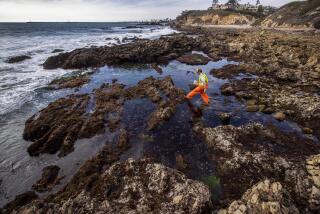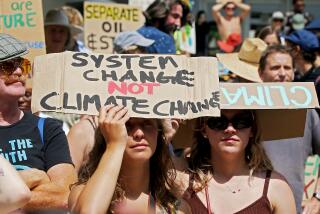Secret Studies Put Spill Damage at $15 Billion
- Share via
Unpublished studies by state and federal researchers contend that the true cost of environmental damage from the Exxon Valdez oil spill in Alaska could be as high as $15 billion, according to experts familiar with the secret reports.
The figure stands in dramatic contrast to the $1.125-billion settlement that Exxon Corp. agreed to last week to settle criminal and civil complaints brought by the state of Alaska and the federal government.
Alaska Gov. Walter J. Hickel arrived at the lower amount without consulting the scientists and economists whom taxpayers paid more than $70 million to evaluate the 1989 spill’s impact. The researchers’ lowest estimate of spill damage--about $3 billion--is close to what Exxon says it would lay out in total, between its cleanup spending to date and the proposed settlement.
The studies--conducted by government research teams including two Nobel laureates--are based on a method that has been used for decades in setting government policy. But their economic modeling technique has never been tested in court, and government lawyers concluded that it was too risky to try to defend it in a criminal trial.
U.S. District Judge L. Russel Holland--who has not seen the studies but rejected an earlier settlement as insufficient to deter future spills--begins hearings in Anchorage today to consider the latest effort to settle charges against the oil company for fouling the water and shores of Prince William Sound.
Meanwhile, scientists, economists and environmentalists familiar with the studies fear that many of them may never become public.
“Everyone is concerned that if the settlement goes through, (the studies) will be deep-sixed,” said Erik D. Olson, a senior attorney with the Natural Resources Defense Council in Washington.
Though there are also scientific studies among the government’s secret research documents, most closely guarded are the reports that estimate the economic effects of the spill.
Olson and others contend that the economic studies show such high damage estimates that they are a potential embarrassment to government negotiators eager to avoid a criminal trial focusing on oil-spill damage just as Congress takes up debate over opening the Alaska National Wildlife Refuge to oil exploration.
Attorneys for both the state and federal governments deny that the debate about the wildlife refuge--regarded by environmentalists as pristine wilderness that should be protected from development and by pro-development forces as potentially the continent’s greatest untapped oil reserve--has anything to do with the agreement.
Government lawyers say that the research is being kept secret because it may still be used in the hundreds of unresolved civil lawsuits that will remain even if the government settlement is approved. In any event, they are highly skeptical that a jury could be persuaded to award anything like $15 billion in damages for the March, 1989, disaster.
“I have never seen any information usable in court that would support a verdict in that range,” said a U.S. Justice Department official familiar with the case.
Many associated with the government studies say their results seemed to play virtually no role in the discussion of settlement terms.
Some point to Hickel’s boast, made to an Anchorage reporter weeks after his election last fall, about the size of a possible settlement with Exxon. “I haven’t come down on a figure,” he told the reporter, “but just use the figure of a billion dollars. . . . I have had a boat down there for 30 years. . . . I know the Sound.”
Hickel revived the $1-billion figure in settlement talks last month in Washington. “And that was the figure the state litigation team was very comfortable with,” said Alaska Atty. Gen. Charles Cole.
Critics of the agreement maintain that the research shows that the proposed agreement sells the Alaskan environment short.
“It’s obvious that the damages in the studies are orders of magnitude higher than the settlement,” said Macon Cowles, a Denver attorney who sits on the steering committee of attorneys managing 300 other cases against Exxon and Alyeska Pipeline Service Co., operator of the trans-Alaska oil pipeline and the marine terminal at Valdez, Alaska.
Moreover, many economists say that the research technique behind most of the higher damage estimates--called “contingent valuation”--is a conventional method used to help form public policy in other arenas. They say it is the best tool they have and one that has been used since the 1950s for placing value on such shared public goods as the environment, interstate highways or defense.
Environmentalists say significant support for a higher damage estimate came last March when the federal government released a summary of state and federal scientific findings about the spill.
Though Exxon has claimed “robust recoveries” of natural resources in Prince William Sound, the summary showed much more destruction of plant and animal life than had been estimated before. Critics contend that even these summaries may not reflect the full studies’ findings.
“I think the summaries may, if anything, be watered down,” said Richard A. Jameson, an Anchorage attorney representing approximately 900 private plaintiffs suing Exxon and Alyeska.
One source with access to the scientific studies said that sections of the summaries lack crucial figures, particularly in the damage to kelp, which is key to herring and other fish populations.
“That’s a charge we have not yet heard,” responded Steven Goldstein, a spokesman for the U.S. Department of the Interior.
Almost all information about the economic studies has been kept secret by non-disclosure clauses in contracts that are described by one source as “a mile wide and a mile deep.” At least one researcher bought a fax machine for his home to ensure that data did not leak outside the research team.
The three teams doing separate economic studies--researchers hired by the state of Alaska, the federal government and Exxon--include most of the country’s top experts in the tiny world of environmental damage estimates. All three studies are described as state of the art and comprehensive.
Nobel laureate economists connected with the studies include Robert M. Solow of MIT on the Alaska team, James Tobin of Yale University on the federal team and Kenneth J. Arrow of Stanford University and George Stigler of the University of Chicago, both doing research for Exxon.
The state team’s estimates range from $3 billion to as high as $15 billion for damages to Prince William Sound, though there are some indications that they have begun to focus on a much narrower range. Federal researchers apparently see a range of $4 billion to $10 billion. Exxon spokesman Lance Lamberton declined comment on anything having to do with Exxon’s studies.
More to Read
Sign up for Essential California
The most important California stories and recommendations in your inbox every morning.
You may occasionally receive promotional content from the Los Angeles Times.










